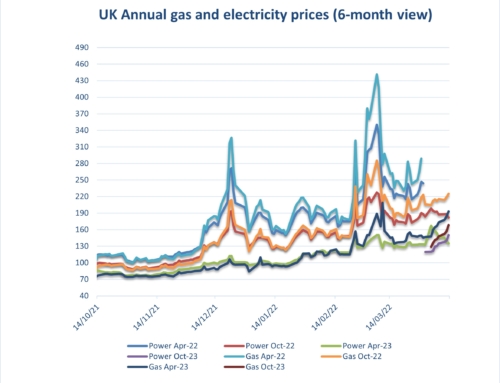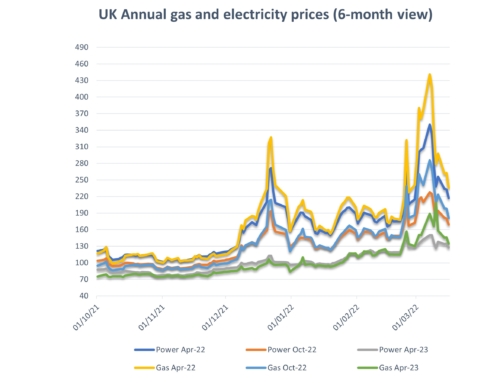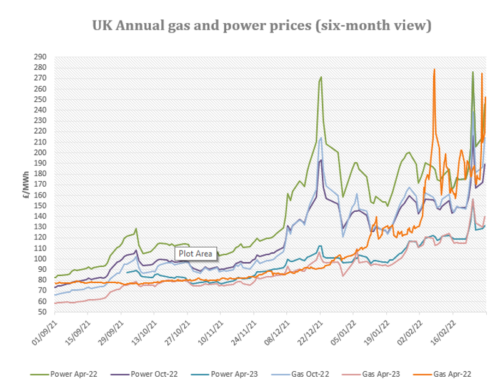Energy costs: In the second half of January mild temperatures, a slump in oil prices, healthy wind output and plentiful LNG deliveries all helped to drive both short and long term gas and electricity prices to 2016 lows. However, this morning revised forecasts of a short term drop in temperatures, combined with talk of an intervention from OPEC to step back production limiting oversupply arising from the Chinese economic slowdown due to Coronavirus has caused prices to spike. We may see continued backtracking over the coming days as the market resists further falls.
Upside:
Outages – Wind output from Scotland in a number of Scottish farms is likely to remain idle for a further fortnight due to an outage in cable between Scotland and England. Further outages in North Sea gas production will continue until the end of March.
Oil pricing – Oil prices have tumbled due to oversupply caused by the Coronavirus. OPEC are likely to set further production restrictions to stem this, which may feed through to price increases.
Downside:
Gas Storage – This remains significantly high across Europe at 72% fullness; compared to 52% fullness this time last year.
LNG Deliveries – As prices continue to slump in the Far East due to reduced demand related to the Coronavirus, more deliveries are expected to head towards Europe and the UK.
Carbon (CO2) Markets – Prices are falling following the announcement the UK would resume auctions in March.
Could go either way:
Brexit/Sterling – The UK left the EU on 31st January. The status quo continues until December 31st by which time a trade deal must be negotiated. The rhetoric has already started on both sides.
Coal Markets – Coal prices remained volatile caught between a reduction in Australian output due to the bushfires and reduction in Chinese demand due to Coronavirus.
Temperatures – The UK is expecting a cold snap over the next week but temperatures should return to above seasonal norms afterwards.
Wind output – Wind generation is predicted to reduce this week but should increase next week.
Non-energy costs:
On the electricity side organisations will see further increases in pass through costs from both government and industry infrastructure providers in the coming months as distribution, Electricity Market Reform (EMR),Capacity Market and Energy Intensive Industries (EII) charges are ramped up.
Climate change levy (CCL) increased significantly from April 1st to offset the loss of CRC to Government revenues. Please see the attached pass through charge information for details. Your CCA related CCL exemption rates will increase at the same time (Gas 78%, Electricity 93%). Please ensure your PP11 forms are updated and sent through.
Warning: more gas suppliers are passing through backdated Un-identified Gas (UIG) charges for 2017/18. Please contact us if you have any questions or unusual gas bills.
Is your organisation covered by the new Streamlined Energy and Carbon Reporting (SECR) scheme?
Designed to replace in part the Carbon Reduction Commitment (CRC) which ends this year and to follow on from the energy savings recommendations generated by ESOS compliance. Note, SECR will cover a wider scope of organisations than CRC and ESOS do. Full details are attached below.
SECR will require all large enterprises to disclose within their annual financial filing obligations to Companies House, their greenhouse gas emissions, energy usage (from gas, electricity and transportation as a minimum), energy efficiency actions and progress against at least one intensity ratio.
The scheme came into effect on April 1st, 2019 and will be required to be included in the first set of accounts published for financial years starting after this date.
The scheme covers publicly quoted companies (extending their current disclosure requirements) and UK incorporated companies or LLPs with two or more of the following.
- More than 250 employees
- A turnover in excess of £36 million
- A balance sheet in excess of £18 million.
UK subsidiaries, who meet the eligibility criteria, but are covered by a parent group’s report (unless the parent group is registered outside the UK) and companies using less than 40,000 kWh of energy during the reporting year do not have to provide disclosure. Note the reporting year should be aligned to your financial year.
Are you eligible for an EII rebate?
Under current rules, if you qualify at an industry sector level and your business passes the 20% electricity intensity test you may qualify for exemption to CFD and RO charges. Please see the attached Government RO/CFD guidance document and give me a call to discuss this further.
A copy of our detailed market report is available: Eneco Market Information early Feb 2020
Gas and electricity prices from 2009 to date are available here: Eneco Gas and Electricity Pricing Trends Sept 2009 to early Feb 2020
A copy of our environmental charges and Climate Change Levy rates from 2012 to date: Environmental Pass Through Charges and CCL ppkWh Updated 05.11.19
A copy of RO/CFD guidance document: RO_CFD_Guidance_Revised_July_2018
SECR: SECR EA Guidelines




